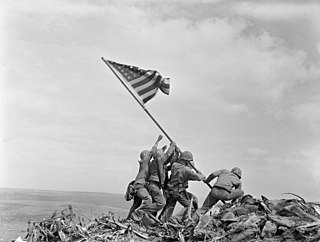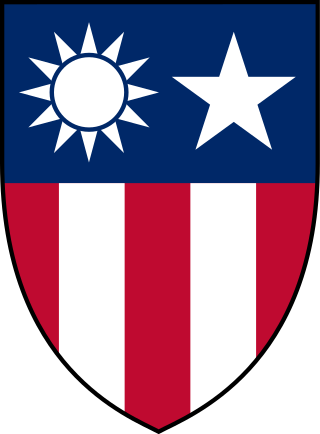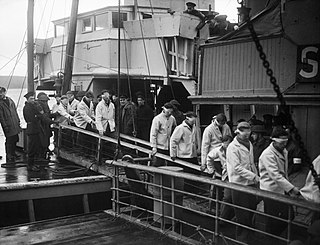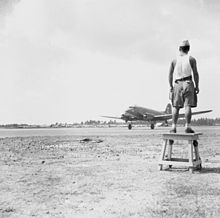
A prisoner of war (POW) is a person who is held captive by a belligerent power during or immediately after an armed conflict. The earliest recorded usage of the phrase "prisoner of war" dates back to 1610.

The Cairo Conference, also known as the First Cairo Conference, was one of 14 summit meetings during World War II, which took place on November 22–26, 1943. The Conference was held at Cairo in Egypt between China, the United Kingdom and the United States. Attended by Chairman Chiang Kai-shek, British Prime Minister Winston Churchill and US President Franklin D. Roosevelt, it outlined the Allied position against the Empire of Japan during World War II and made decisions about post-war Asia.

The Pacific War, sometimes called the Asia–Pacific War or the Pacific Theater, was the theater of World War II that was fought in eastern Asia, the Pacific Ocean, the Indian Ocean, and Oceania. It was geographically the largest theater of the war, including the Pacific Ocean theater, the South West Pacific theater, the Second Sino-Japanese War, and the Soviet–Japanese War in the last few months of the war.

The final battles of the European theatre of World War II continued after the definitive surrender of Nazi Germany to the Allies, signed by Field Marshal Wilhelm Keitel on 8 May 1945 in Karlshorst, Berlin. After German leader Adolf Hitler's suicide and handing over of power to Grand Admiral Karl Dönitz on the last day of April 1945, Soviet troops conquered Berlin and accepted surrender of the Dönitz-led government. The last battles were fought on the Eastern Front which ended in the total surrender of all of Nazi Germany’s remaining armed forces such as in the Courland Pocket in western Latvia from Army Group Courland in the Baltics surrendering on 10 May 1945 and in Czechoslovakia during the Prague offensive on 11 May 1945.
The 11th Army Group was the main British Army force in Southeast Asia during the Second World War. Although a nominally British formation, it also included large numbers of troops and formations from the British Indian Army and from British African colonies, and also Nationalist Chinese and United States units.

The British Fourteenth Army was a multi-national force comprising units from Commonwealth countries during the Second World War. As well as British Army units, many of its units were from the Indian Army and there were also significant contributions from the British Army's West and East African divisions. It was often referred to as the "Forgotten Army" because its operations in the Burma campaign were overlooked by the contemporary press, and remained more obscure than those of the corresponding formations in Europe for long after the war. For most of the Army's existence, it was commanded by Lieutenant-General William Slim.

The Indian Army during World War II, a British force also referred to as the British Indian Army, began the war, in 1939, numbering just under 200,000 men. By the end of the war, it had become the largest volunteer army in history, rising to over 2.5 million men in August 1945. Serving in divisions of infantry, armour and a fledgling airborne force, they fought on three continents in Africa, Europe and Asia.

South East Asia Command (SEAC) was the body set up to be in overall charge of Allied operations in the South-East Asian Theatre during the Second World War.

The Burma campaign was a series of battles fought in the British colony of Burma. It was part of the South-East Asian theatre of World War II and primarily involved forces of the Allies against the invading forces of the Empire of Japan. Imperial Japan was supported by the Thai Phayap Army, as well as two collaborationist independence movements and armies. Nominally independent puppet states were established in the conquered areas and some territories were annexed by Thailand. In 1942 and 1943, the international Allied force in British India launched several failed offensives to retake lost territories. Fighting intensified in 1944, and British Empire forces peaked at around 1 million land and air forces. These forces were drawn primarily from British India, with British Army forces, 100,000 East and West African colonial troops, and smaller numbers of land and air forces from several other Dominions and Colonies. These additional forces allowed the Allied recapture of Burma in 1945.

The South-East Asian Theatre of World War II consisted of the campaigns of the Pacific War in the Philippines, Thailand, Indonesia, Indochina, Burma, India, Malaya, and Singapore between 1941 and 1945.

China Burma India Theater (CBI) was the United States military designation during World War II for the China and Southeast Asian or India–Burma (IBT) theaters. Operational command of Allied forces in the CBI was officially the responsibility of the Supreme Commanders for South East Asia or China. In practice, U.S. forces were usually overseen by General Joseph Stilwell, the Deputy Allied Commander in China; the term "CBI" was significant in logistical, material and personnel matters; it was and is commonly used within the US for these theaters.

Disarmed Enemy Forces is a US designation for soldiers who surrender to an adversary after hostilities end, and for those POWs who had already surrendered and were held in camps in occupied German territory at the time. It was General Dwight D. Eisenhower's designation of German prisoners in post–World War II occupied Germany.

Operation Tiderace was the codename of the British plan to retake Singapore following the Japanese surrender in 1945. The liberation force was led by Lord Louis Mountbatten, Supreme Allied Commander of South East Asia Command. Tiderace was initiated in coordination with Operation Zipper, which involved the liberation of Malaya.

Thailand officially adopted a neutral position during World War II until the five hour-long Japanese invasion of Thailand on 8 December 1941, which led to an armistice and military alliance treaty between Thailand and the Empire of Japan in mid-December 1941. At the start of the Pacific War, the Japanese Empire pressured the Thai government to allow the passage of Japanese troops to invade British-held Malaya and Burma. After the invasion, Thailand capitulated. The Thai government under Plaek Phibunsongkhram considered it profitable to co-operate with the Japanese war efforts, since Thailand saw Japan – who promised to help Thailand regain some of the Indochinese territories which had been lost to France – as an ally against Western imperialism. Following added pressure from the start of the Allied bombings of Bangkok due to the alliance with Japan, Thailand declared war on the United Kingdom and the United States and annexed territories in neighbouring countries, expanding to the north, south, and east, gaining a border with China near Kengtung.

During World War II, it was estimated that between 35,000 and 50,000 members of the Imperial Japanese Armed Forces surrendered to Allied service members prior to the end of World War II in Asia in August 1945. Also, Soviet troops seized and imprisoned more than half a million Japanese troops and civilians in China and other places. The number of Japanese soldiers, sailors, marines, and airmen who surrendered was limited by the Japanese military indoctrinating its personnel to fight to the death, Allied combat personnel often being unwilling to take prisoners, and many Japanese soldiers believing that those who surrendered would be killed by their captors.

In Dutch historiography, Bersiap refers to the violent and chaotic beginning of the Indonesian National Revolution following the end of World War II in Asia. In Indonesia, the term Berdaulat ("Sovereign") is also used for this transitional period. It began after Sukarno's proclamation of Indonesian Independence on 17 August 1945 and culminated during the power vacuum between the withdrawal of Japanese occupational forces and the gradual buildup of a British military presence, before the official handover to a Dutch military presence in March 1946.

The 1945–1946 War in Vietnam, codenamed Operation Masterdom by the British, and also known as the Southern Resistance War by the Vietnamese, was a post–World War II armed conflict involving a largely British-Indian and French task force and Japanese troops from the Southern Expeditionary Army Group, versus the Vietnamese communist movement, the Viet Minh, for control of the southern half of the country, after the unconditional Japanese surrender.

Large numbers of German prisoners of war were held in Britain between the outbreak of the Second World War in September 1939 and late 1948. Their numbers reached a peak of around 400,000 in 1946, and then began to fall when repatriation began. The experiences of these prisoners differed in certain important respects from those of captured German servicemen held by other nations. The treatment of the captives, though strict, was generally humane, and fewer prisoners died in British captivity than in other countries. The British government also introduced a programme of re-education, which was intended to demonstrate to the POWs the evils of the Nazi regime, while promoting the advantages of democracy. Some 25,000 German prisoners remained in the United Kingdom voluntarily after being released from prisoner of war status.
The Italian Service Units or ISUs were military units composed of Italian prisoners of war (POWs) that served with the Allies during World War II against Nazi Germany and the Empire of Japan from May 1944 to October 1945. The armed forces of the United States captured many Italian soldiers during the North African campaign Operation Torch, which started in November 1942 and sent 51,000 of them to the United States. After the signing of the armistice by the Badoglio government in Italy on September 8, 1943, and with Pietro Badoglio and the Kingdom of the South officially declaring war on Nazi Germany on October 13, 1943, the Americans began to see the POWs as potential allies. The capture of Rome by the Allies on June 4, 1944, motivated many POWs to change sides. About 90% joined Italian Service Units, which operated in the United States and overseas.
Allied prisoners of war in Japan suffered from very harsh conditions. Many died due to disease, malnutrition, overwork, or deliberate murder. Like other Axis Powers and the USSR, Japan significantly ignored provisions of international treaties regarding humane treatment of prisoners. As a result, in the Asian and Pacific theater, the Allies respected the Geneva Convention and treated Japanese prisoners humanly, which was not reciprocated by the Japanese.



















